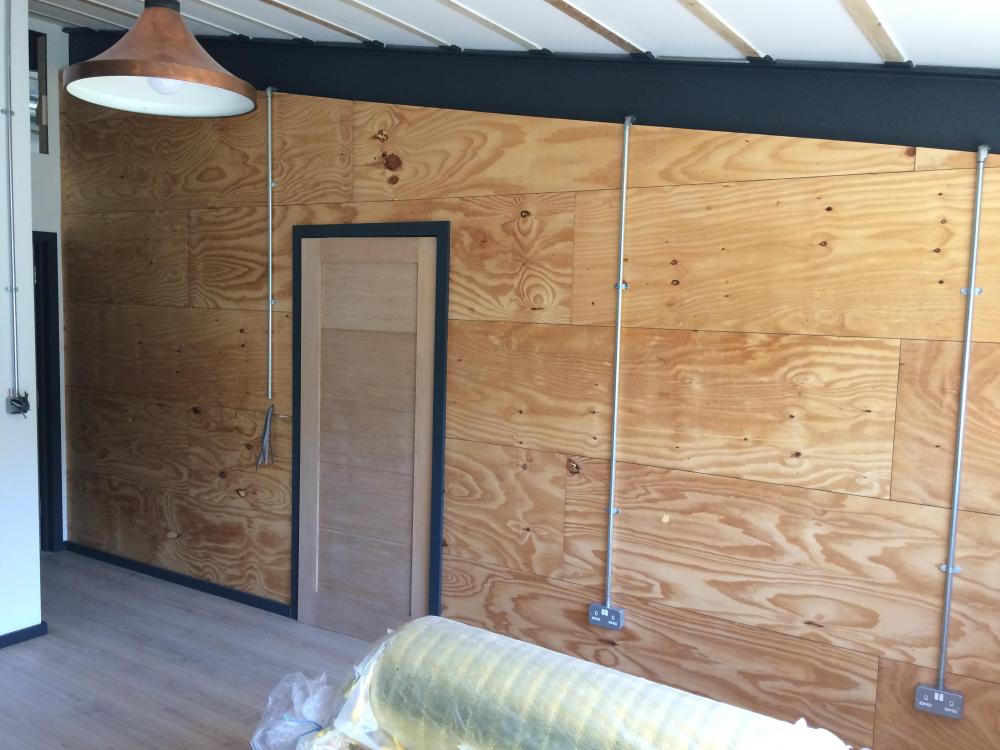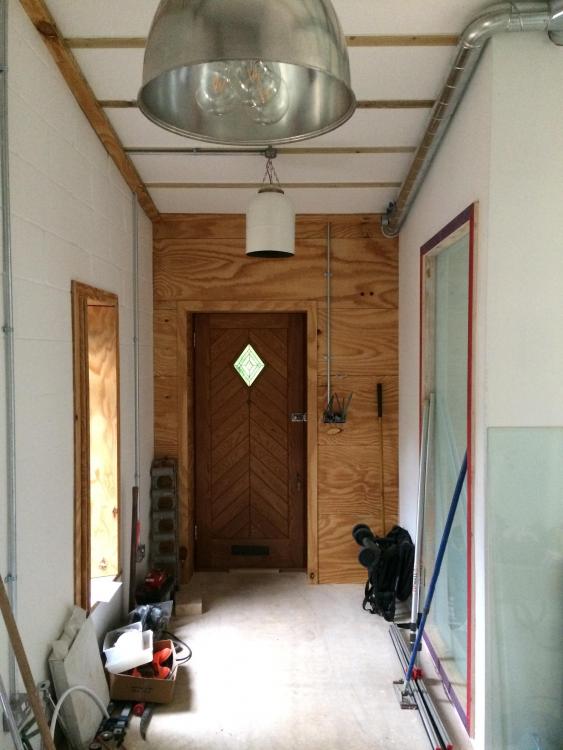Leaderboard
Popular Content
Showing content with the highest reputation on 01/04/23 in all areas
-
Just wanted to tell about my long and hard fought planning battle to finally get approval for anyone else in a similar situation who's losing hope. I bought a plot of land in a development area of a town with FPP for a traditional detached house back in 2020. I then worked with an architect to create a new highly contemporary design that better suited my needs and preferences and submitted it to the LPA, optimistically expecting a decision in 8 weeks time. There were no objections from the local town council nor any technical objections. The plot isn't in a conservation area, AONB or in any other special zone which might cause planning issues. Myself and my planning consultant expected this to be a quick and simple application. My planning consultant had an initial call with the case officer who said they didn't see any issues. All seemed good so far. Then a month later, after chasing the CO again, they came back and said that they had decided that there was no way they could give us approval for the house as it was too out of character for the area and that there was nothing we could do, revise or prove to change their mind. We argued that it wasn't out of character for the area, and that the same case officer had actually themselves approved several applications for contemporary houses nearby and written in their reports that there was no overriding architectural style in the area. They told us to argue it at appeal. At this point, I contacted the head of the LPA who seemed confused why the CO was refusing to allow us to even submit any additional evidence to show that it wasn't out of character. The CO reluctantly relented and said we now could submit additional evidence. I went all out on this - I had drone surveys mapping the whole area showing the house would be completely screened from the road, additional consultants came in to conduct character reviews of the local area, numerous additional architectural drawings etc. Upon informing the CO that all additional evidence would be submitted the following week, they replied and said they'd changed their mind about allowing additional evidence and were going to just reject the app. I contacted the head of the LPA about this to complain a few days later, who replied saying that the CO had actually just quit their job, we would be assigned a new CO and they'd be happy to review any additional evidence. A friendly local councillor passed on information about why we were having so much difficulty with this app - a local married councillor duo, who had a reputation for 'shouting the loudest' to get their own way, were doing everything they could to get the LPA to reject my app. At the town planning committee when my app was discussed, they had said they wanted to prevent all contemporary houses from being built and were apparently outraged that the committee sided with me and voted to raise no objection. This was their revenge. The new CO was far more amenable - he wanted to work with us to tweak the design to something he felt he could then approve. We spent two months going back and forth with designs and changes until he finally said that he was satisfied and would write a report giving us approval. This was about 7 months after the application was originally verified. I was obviously very pleased with this outcome and patiently awaited their report. A month passed before we followed up with them to see how they were getting on. Imagine our surprise when we were informed that this CO had also quit two days ago and we'd now get a third CO. The third CO looked at the original plans and the redesigns and said he much preferred the original plans to the redesigned version and would be happy to approve it with some minor tweaks, which we happily obliged. He then began writing his report recommending approval, and we waited and hoped this one wouldn't quit too. A month passed and we received confirmation his report was ready and just needed to be signed off by their line manager. A few weeks later and we find out there's a problem - the line manager refuses to sign off on it and tells him to re-write it as a refusal, stating 'overlooking' as the reason. This particular line manager is known to be friendly with married councillor duo. We obviously push back very hard on this as we have 3d drone surveys showing that overlooking is not possible, and that there is substantial distance between neighbouring properties which are well above guidelines for new builds anyway. I once again get the head of LPA involved and the line manager agrees to at least to do a site visit with the CO. At the site, the line manager begrudgingly admits defeat and allows the recommendation for approval. It's a little over a year since the app was verified. The journey's not over yet though, as it turned out that a ward councillor had called in the app to committee when it was first submitted but had gone unnoticed due to the multiple CO changes. I felt reasonably confident going into the committee though - we had an officers recommendation for approval, there was no 5 year housing supply in the area so development was favoured, and I wrote a very strong speech putting forward my case. At the committee I gave my speech and then listened the councillors debate. To my horror, this was when I found out that councillors don't actually bother to review planning documents for applications they're voting on - multiple councillors said they couldn't support it because they didn't know what materials would be used (despite all materials been listed numerous times in the docs) and one even saying they couldn't support it based on architectural drawings as they wanted illustrations (but there were multiple CGIs submitted in the docs). In the end, 4 councillors voted to refuse the app (2 were the married couple duo who said nothing during the debate and the other said they 'didn't like it' as their reason) but that was enough to overturn the CO recommendation as so many others abstained. Not willing to give up after how much work had already gone into this, I had my planning consultant start work on the appeal. We submitted a 50 page rebuttal of the committees one reason for refusal (contemporary design would be out of character). The LPA barely even tried to justify the committee decision, they submitted a 3 paragraph argument, seemingly acknowledging that they were fighting a lost cause. 6 months later and just in time for Christmas, we received the Inspectors report that the appeal was allowed. Almost exactly two years to the date after the app was first verified. The two year battle cost me ~£30k and building costs have gone up ~£300k during that time (the GDV has gone up by more than this but it is still painful). It was worth it in the end though to finally be able to build the house I want to build. Just wanted to tell my story for anyone else who's in a similar struggle at the moment and advise you to just keep pushing forward.2 points
-
Contractor wants shooting. He has taken an inadequate, not fir for outside feed to a light, fitted a crappy non waterproof box, without even trying to waterproof the conduit entries and joined his SWA gate feed to it. It is full or water, witness the rusted SWA gland. you have found the solution to your tripping. Rip it ALL out and start from scratch with SWA from the house.2 points
-
This makes my blood boil, but well done you for sticking it out. There ought to be an independent complaints body with the power to remove the right of councillors to be on a planning committee if they're shown not to follow the rules.2 points
-
My past experience is event / festival sites where everything is run in a mix of 240v and 415v. The risk profile of an outdoor event site - especially during build and strike - is probably not that different to big construction. That said absolutely everything was on a commando plug until the very final socket (which was usually a single commando - 13a adaptor for a specific piece of kit). So imho 110v definitely has safety benefits but it is possible to make higher voltages work safely with sensible controls in place. If you have 240 on site for chargers then unless you police it there's a fair risk someone turns up with a 240v tool in their van and runs an extension lead(s) for it which IMO would be worse than having a safe 240 supply around the site.2 points
-
The “new improved” soon becomes the norm and people expect more. I grew up in a council house with a coal fire, no central heating and single glazed steel windows … in winter there was often ice on the inside of the windows but we survived. Now anyone not able to keep their central heating on is vulnerable and going to die.2 points
-
https://static.rippleenergy.com/assets/KirkHill/Ripple-Coop2-rules.pdf So you need 75% of members present (not shares) at a general meeting to change the model, and 90% to carpetbag it. Pretty tall order.1 point
-
Thats sort of the reason i jumped into this thread. I saw numbers being mentioned here that appear to be at odds with what i have learned so far. I need a breakdown, itemised line by line of the elements that are lumped into my 'weathertight package' phase of my build. At the moment i have an opaque figure for the package as a whole. It might turn out to be great value but as of today i dont have enough info to determine this.1 point
-
Why..?? Have a look at the Sky Glass ones and they start at 42” and that’s a pretty decent TV ..! 55” is nuts unless you can sit about 20 feet away from it ..!1 point
-
Sounds like an excellent opportunity for some EWI as the render is the majority of the cost anyway.1 point
-
I run a render company and use most types and brands of render I used K scraped on our build and plan to use K Roughcast on our current build Both breathable Expect to pay £50-60 m2 Dont use a local plasterer that does a bit of rendering 50-60 will get you an established company that will have lots of finished and ongoing jobs you can go and see1 point
-
Choose your tv mount then plan the wiring. As a minimum fit a DOUBLE socket with two USB outlets so you can power other devices, e.g. a firestick. 3 hdmi cables to "somewhere" you might want to locate set top boxes, game consoles etc. A spare conduit and draw cord for whatever supersedes hdmi (if you were doing this 20 years ago you would have installed a load of scart cables....) And some coax for a good old fashioned television aerial seems a pretty good idea. Sockets are best just above the tv bracket, there tends to be a little more space, as long as they are not so high they show above the tv. Are you happy with the generally lousy sound from most inbuilt speakers in tv's or would you like a nice surround sound system?1 point
-
Just looks like mortar infil to me - the arch is doing all the work there by the looks of it. If you’re handy with a grinder and have a decent scaffold to work from then you could helibar it yourself using one of the kits - it’s basically 30mm deep cuts with 6mm twist bars and then epoxy grout inserted into the cracks. That will stop it moving any more and you can always drill and inject epoxy mortar into the crack too.1 point
-
My understanding is different, I would've thought that this is reduced rate 5%1 point
-
Absolutely vital to replace with SWA. The whole point of SWA is that whatever might accidentally penetrate it will first make contact with the armor which is earthed at the feed end and then make contact with live causing the circuit breaker to trip while the potential of the (garden fork) remains close to ground.1 point
-
F*** me, potentially worse than I thought 😂 Until now I thought my neighbours was the worst I'd ever seen. They used push fit pvc conduit and glands but nothing was sealed/glued. Does this circuit have it's own breaker/fuse?1 point
-
1 point
-
That is a ****fest. Not even proper glands used for the conduit, just a hole. Is that SWA actually earthed to the banjo? Neighbour paid a fortune for oak swing gates and the wiring looked just like that. Tbh I'd use flexible conduit and come in from the bottom in 3 holes.1 point
-
Have you had a look at the Hebhomes Longhouses? they are relatively barn style, and you can use them to see if the planners are up for it and if you can afford them. https://www.hebhomes.com/our-homes/layout/lh402p1 point
-
75 screed 150 pir 10 sand 90 hardcore or sub-base. = 325 Porches are not warm places, and it will be unheated, so 150PIR is plenty, perhaps too much but allows if heating is added later. So revised: 75/100/10/140 If diy and the screed is likely to be rough then reduce to 65 screed than 10 levelling compound.1 point
-
Obviously didn't try to hard, first hit on datasheet for the above. 10.7kW min while condensing. https://www.baxi.co.uk/our-boilers/system-boilers/baxi-platinum-plus-system1 point
-
White render is ubiquitous in the Highlands and NE Scotland. Lots going up in Fife too. It is the fake stone effect they don't want, and i saw lots around Banchory I think. That right hand picture is unusual. 1.5 storeys is the norm. I'd say that was 1.75. My belief is that you can stick build cheaper than kit build, (management excluded) so you don't have to use a standard design. But rectangular is good.1 point
-
Not if tied down to a concrete base and properly backfilled. From discussions with a digger driver* it is clear thst most builders do not follow any instructions...so establish the design and manage it yourself. *He dug the hole, put in our stone base, hoisted the digester tank, and backfilled. Later did the soakaway. He had done many tanks, mostly digesters. We have no water table. He said he had never seen anyone use a level for height or horizontal, used a concrete base, or used more than a rubble soakawsy. Scary.1 point
-
Planners in Scotland will happily allow white render. The Scottish white house cottage or farmhouse is common for example. The corner detail is just that a detail and common enough in what was once called exec detached houses. If you ever drive to Pitlochry via A924 about half along up on the hillside you’ll see these two houses. The one on the left is a 19th cottage and the one on the right was built in 2010 as a SIPs timber kit.1 point
-
There are very skinny ones, dependant on bolt connections, that are OK for occasionl DIY. ie better than a ladder, once up on them. But I wouldn't want to be high or use regularly. There appear to be intermediate qualities that snap together, but may be a bit wobbly. Can't comment further. Then there are proper ones. Use these for a substantial project and make sure to have the stabilisers. Wheels worth the extra too. You should be able to get half your money back by selling on.1 point
-
I would personally plasterboard the lot and then skim it. anything else is asking for a crack to appear where the upper plasterboard meets the lower plastered brick.1 point
-
Or oil. Before I got my ASHP I had an external oil boiler. The exhaust made a roaring noise that was audible from some metres away but as far as I can tell such boilers are subject to no noise restrictions whatsoever. There are various new regulations on oil boilers pertaining to efficiency but none on noise.1 point
-
I would go secret gutter and cover over - with that low pitch I’d want all the joints as tight as possible.1 point
-
I believe that I would. I work in the legal industry and am well organised.1 point
-
I've got a feeling not all interlocking tiles can be done with soakers. The soaker messes with the way they interlock. Perhaps get a few samples and do a mockup? Generally flat tiles must have lead soakers not just a flashing strip over the top. Pantiles can get away with just a strip on top if it's wide enough to cover one hump in the tile. Their guide on low pitch roof also says..1 point
-
The exhaust fan is typically only used to light a cold appliance, as once up to incineration temps the process of, then efficient, combustion is self-sustaining. Depends then whether you're a single burn hopper for bi-daily burns or track fed for continuous burn. Last one I specified / installed ( via a HETAS reg company ) worked very well, feeding a single 2600L Galu buffer tank ( @Roger440 there's no coils mate, the huge amount of heat energy wouldn't allow it so you just fire it in to the whole tank as fast as you produce it ) but this lot took up half of a single car garage! Also, it chewed through a barrow full of seasoned wood per single 'burn', but each burn took that buffer to 85oC and provided space heating for 24 hours in an old, leaky, listed, stone cottage. Ergo, the exhaust fan was needed every day to get the beast moving ( plus the Ladomat setup of course ).1 point
-
Sorry a bit of a rant, not directed at anyone. You have a designed system, but not everyone does, you need the whole system to be designed correctly to work well. People are stuffing there houses with trvs, thermostats and zoning everything, thinking it's a magic bullet, while also having an oversized gas boiler - I have also been in the same position. Plumbers like to S and Y plans, but it's crap for boiler efficiency. We learn from it, other don't, I now know on a day to day basis exactly what the boiler is doing and how efficiently, went out if my way to install an energy meter at the UFH manifold. Lots don't read the gas meter from one season to the next. Funny thing in most cases when running multiple zones without an alternative flow path the boiler cannot cope and gas consumption goes up. Most boilers don't modulate as much as yours either, very few houses have a LLH, or buffer, most used to use an always open radiator in the hall, but people put Trvs there as well. Modulation, mine at 30 deg flow temps is about 6:1, many are much worse, I needed a buffer, now I can happily supply 0.5kWh average to the UFH when the weather is about 10-12 degs and the boiler efficiency stays high.1 point
-
Things you need to do or be aware of from what I have seen and read in various manufacturers manuals The minimum open volume of water in the "always open" part of system has to exceed the heat pump manufacturers minimum volume requirements. For example Grant state 30L. So preferably one zone? Noticed in the video reference he installed a buffer as a volumiser. Flow rate through the system has to meet or exceed manufacturer min flow rate and not exceed any defined max flow rate. You may need an alternative to a mixer valve to ensure any supply flow temperature exertion doesn't expose the floor to excessive temperature, such as going from DHW cylinder heating to UFH heating duty. Short periods may be ok depending floor makeup etc. I do notice with my mixer the flow temp from the boiler is always a few degrees hotter than the manifold, due mixing. So this would affect CoP.1 point
-
Most on here including me would advise keeping the manifold pump and blending valve. I did wire a system with a Grant ASHP earlier this year where they only used the single pump in the ASHP but I don't know how that worked out in practice.1 point
-
So close, Dave. I think I'll have to give you that. We have three showers but only use one of them except when visitors are staying. It's been so long that the traps in both of the others had dried out. Took me a day or two to figure it out, but let's just say I ended up following my nose 😉1 point
-
I've just come from a conversation with our planner about exactly this issue. She says that unless PD is explicitly withdrawn, then PD rights remain. Further, PD rights should not be withdrawn without good reason - her comment was something to the effect that Planners are doing so while giving relatively little thought to recent court decisions about the matter. There have been a number of challenges in this area. Be sure to read the PD regulations in context to the building which already exists. (See @Temp above) My advice would be to spend a few quid on asking a local planner to give you properly qualified advice - just in case there's some silly local wheeze... Do your Due Diligence before selecting a Planner to advise you. We are interested (not to say nosey) amateurs on this discussion board. Not experts.1 point
-
I know this isn’t the right sub-forum for this thread, but I never introduced myself when I joined in Oct 2020, just 2.5 months before our RE-build started (which I’ve decided is a tad harder than a new build). In those first six months I spent so much of my time on this forum that by March 2021 when it was my birthday, the forum’s name featured in a gift that SWMBO made me (basically a framed miniature model of all my favourite things, and on the miniature tablet within the miniature model was the buildhub logo - hope she hasn’t committed a copyright breach!) So just wanted to say thanks to everyone for all the support, particularly for making me feel less alone in this journey. Self building can be a very stressful, difficult thing that not many people do; I’m a terrible perfectionist and often my own enemy which makes it all the harder. But I can’t imagine how I would have done it without all the people here. Happy New Year. 2023 has simply got to be better than 2022. Or at least let’s just believe that.1 point
-
It does rely on data collection, which everyone should be doing anyway. It does amaze me that people will spend £100+ on smart light builds, but are unwilling to spend half that on energy monitoring.1 point
-
Thank you to you, my 'friends' too, it's an amazing community. You're a great bunch, even the weird ones 🤣1 point
-
1 point
-
No that is far from crazy.. more a good understanding of how things work and the theory. Ok SE wise @saveasteading is bang on so not crazy at all. The idea is that you make the floor beam deeper so it acts like a deeper timber. Yes you can do this on the top or the bottom of a beam..great idea from @saveasteading it's these small ideas on BH that can save you loads of cash. To make it work you need to make sure that what to add to the top or bottom of the beam is connected to it in such a way that is acts like a solid timber. The best way to do this is to use a structural glue and really clean the mating surfaces. Any dirt is a no no as the glue does not work as intended. Modern structural glues are stroger than a typical softwood.. D4 glue is NOT a structural glue specification. The D stands for DURABILITY.. not structural STRENGTH.. hey folks the clue is in the prefix.. it's a D so don't use it in a structural application and expect your SE to sign off! No point in me pointing out just the problems.. solution is use say Cascamite or similar glue.. this is a STRUCTURAL resin glue and by default meets the durability requirements. But both D4 and resin glues are very hard to clean off your hands so wear gloves! In my day job I'm reluctant to do this plating of timbers unless I really know who the builder is, that they will do what the are told and that the Client is willing to pay the builder to do what is quite a technical job. Alternatively a Client can pay me to supervise the job.. but often they don't want to pay for that last and most crucial part..I have probably saved them thousands by being an old sckool SE.. such is life. But as we are BH folk we will spend that time and attention to detail.. you are more inclinded to do it right! That lifts my spirits as it does (I'm sure) for the MODS and all the other folk that post on BH. Where the ply comes in is that you can also use ply to act like a wider flange like on an enginnered joist and that can give a lot more bang to for your buck. But you like an engineered joist you can't then go cutting service slots and holes in it. It a long storey but @saveasteading has put forward a nugget / great solution.. all you need to do is think if it suits your application. it sounds complcated but if unsure post loads of info on you project / ideas and folk will chip in on how it all could work for you.1 point
-
Good point. Counterbatten underneath? Will still be easier I'd guess. Getting crazier here.......plywood on the bottom, which may even work better, and your floor boards provide even more stiffening, then batten underneath at plasterboard centres, thus creating a service void. Or your way and drill holes.1 point
-
Actually, the sloped screed with tanking on top then pavers on pedastals is the answer. Just need a route for the water to leave the deck.1 point
-
We're doing exactly the same. Raised patio out the back of the house, with a storage area underneath. I'm looking at span tables now before sending sketches off to architect and SE. My thoughts are also firmly on waterproofing. First, flashing against the house, secondly, a cement based tanking slurry over the beam floor. Paving over. The bit I'm worried about is how to get rid of the water on top of the beam floor. Inevitable that water will soak through the pavers and screed, and then sit on the tanked surface. I'm worried it'll be perpetually wet and lead to a horrible slimy surface. Alternative is to screed with a fall, then tank. Still trying to figure it out.1 point
-
Just what the board came with, its just the isolator rating, not an issue. Usually they are 80A and 63A or a combination of such, there is usually a bigger one for heavier loads. The issue you will also have is cascading, which RCD trips first?!? When the RCD goes, is it only ever the one at the supply and not the CU? This is why my garage is on a 50A SWA submain fed from an MCB in the house CU. So when I drop my extension cable in a bucket of water only the RCBO for that circuit in the garage goes and because I used RCBO's for each circuit, I still have lighting on in the garage to go reset the small power RBCO!1 point
-
I think I would be looking at doing some upgrades and changes to this setup. That RCD's is protecting as entire, pretty bad way of doing it as you are finding. I cannot see from this image but the tails feed the little CU - then that must feed a cable which feeds the distant consumer unit, I can only assume that it's like this to protect a submain that needed protection under BS7671 but its a poor poor way of doing it. I would be getting rid of that RCD, running an armoured sub-main to the distant consumer unit, then think about having it rewired with a RCBO board ideally or split board if, and I will make the assumption, it doesn't have any RCD protection. Are the freezers in a garage? I would also be looking at getting those tails and things upgraded. Not sure what the "local circuits" are on the small lower CU but I am sure with a bit of thought this could all be revised and made quite a bit better. The BS88 fuse appears to be a 60 - I would be tempted to get rid of the Henley blocks and mess of old tails, run two new tails into a new 4-6 way CU - feed the local circuits from a RCBO, and feed the distant CU with an MCB - probably a 63A or 80A unit - single pole MCB's of that rating are not too easy to find but do exist. Run that out on SWA to the house distant house consumer unit. That then takes care of your submains and you can worry about the main house consumer unit at a later date. I can think of 2-3 other ways of doing this, but that is an option.1 point
-
We've internorm 310s throughout the house and are very, very happy with them. We got 3 quotes, they came out in the middle. (£22k, 34k, and £40k). Definitely get quotes for your build as companies price in different ways, and some can't do certain dimensions or styles others can. E.g. internorm were the only ones that could do 2400mm tall patio doors and a 2200mm tilt and turn window.1 point
-
It now has what it calls an intermittent mode (which is new to me), which sounds like that. I bought them initially for the trickle mode, which only uses 3W on low trickle vs 15W on boost and 20W on 'intermittent', and their third-off the price "carbon reduction week" where there is an 80% efficiency heat exchanger and separated as far as possible inlets and outlets. There's also some burble about maintaining a slightly reduced air pressure relative to the rest of house for something something something reasons, which I think is probably half burble but also a minor effect. https://www.vent-axia.com/range/lo-carbon-tempraselv And having a PIV at the other end of the house helps resist eg towels on radiators or the "what? windows open?" tendency. F1 point
-
1 point




.jpg.c21f3ac78c9b7efd90cbdcb312744dc5.thumb.jpg.7adcad4c0e384f5ecd7d56b0618df6e5.jpg)















